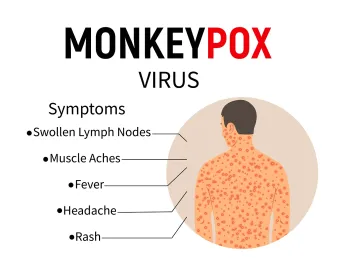As Monkeypox (MPX) continues to be an issue throughout California, Cal/OSHA issued guidance to assist in protecting employees. However, this guidance applies only to workplaces covered by the Aerosol Transmissible Diseases (ATD) standard, which is notable because the guidance itself states that “MPX spreads primarily by close or direct contact with infectious rashes, lesions, scabs, or body fluids.” However, the guidance also states that “the virus can become airborne during changing or handling of contaminated linen.
Workplaces covered by the Cal/OSHA ATD Standard include the following:
-
Hospitals
-
Skilled nursing facilities
-
Clinics, medical offices, and other outpatient medical facilities
-
Home health care
-
Long-term health care facilities and hospices
-
Medical outreach services
-
Paramedic and emergency medical services
-
Medical transport
-
Homeless shelters (includes migrant shelters)
-
Drug treatment programs
-
Laboratories that perform procedures with materials that contain or are reasonably anticipated to contain aerosol transmissible pathogens
The guidance sets forth distinct requirements for outpatient clinics, dental offices, hospitals, and other employers covered by the ATD standard. Since this guidance is very specific, we recommend reviewing the requirements directly from the Cal/OSHA guidance linked above.
The guidance also provides that all employers covered by the ATD standard must provide and ensure uses of respiratory protection defined as fit-tested, NIOSH-approved particulate respirator equipped with an N95 filter or higher, for employees who:
-
Enter a room occupied by an airborne infectious disease case or suspected case, including MPX;
-
Enter an airborne infection isolation room or area that is in use for airborne infection isolation;
-
Are present during procedures or services on an airborne infectious disease case or suspected case, including MPX;
-
Repair, replace, or maintain air systems or equipment that may contain or generate aerosolized pathogens;
-
Work in an area occupied by an airborne infectious disease case or suspected case, including MPX;
-
Are present during decontamination of an area where an infected patient or client was located;
-
Work in a residence where an airborne infectious disease case or suspected case, including MPX is known to be present;
-
Are present during the performance of aerosol-generating procedures on patients suspected or confirmed to have an airborne infectious disease such as MPX (powered air-purifying respirator or better);
-
Are present during the performance of aerosol-generating procedures on cadavers that may be infected with aerosol transmissible pathogens (powered air-purifying respirator or better);
-
Perform a task for which the Biosafety Plan or Exposure Control Plan requires the use of respirators;
-
Transport an airborne infectious disease case or suspected case, including MPX, within a facility or in an enclosed vehicle when the patient or client is not masked; or
-
Handle linen potentially contaminated with MPX unless effective procedures are used that prevent the release of virus particles.
Covered employers must also provide personal protective equipment (PPE) to employees exposed to a person with or suspected to have MPX, including gowns, gloves, and eye protection.
Finally, covered employers must implement written procedures for exposure incidents (aka a “significant exposure”), which is more specifically defined in the guidance. For such incidents, the following obligations will apply under the ATD Standard:
-
Notify workers who had a significant exposure of the date, time, and nature of the exposure.
-
Provide a post-exposure medical evaluation by a physician or other licensed healthcare professional (PLHCP) knowledgeable about MPX, including appropriate vaccination, prophylaxis, and treatment.
-
Provide post-exposure prophylaxis (i.e., vaccination for MPX) as soon as possible; often done through the local health department.
-
Report the exposure to the local health officer.
-
Remove the employee from the workplace if the PHLCP or local health officer recommends precautionary removal. Maintain the employee’s pay, rights, benefits, etc. during precautionary removal.




 />i
/>i


